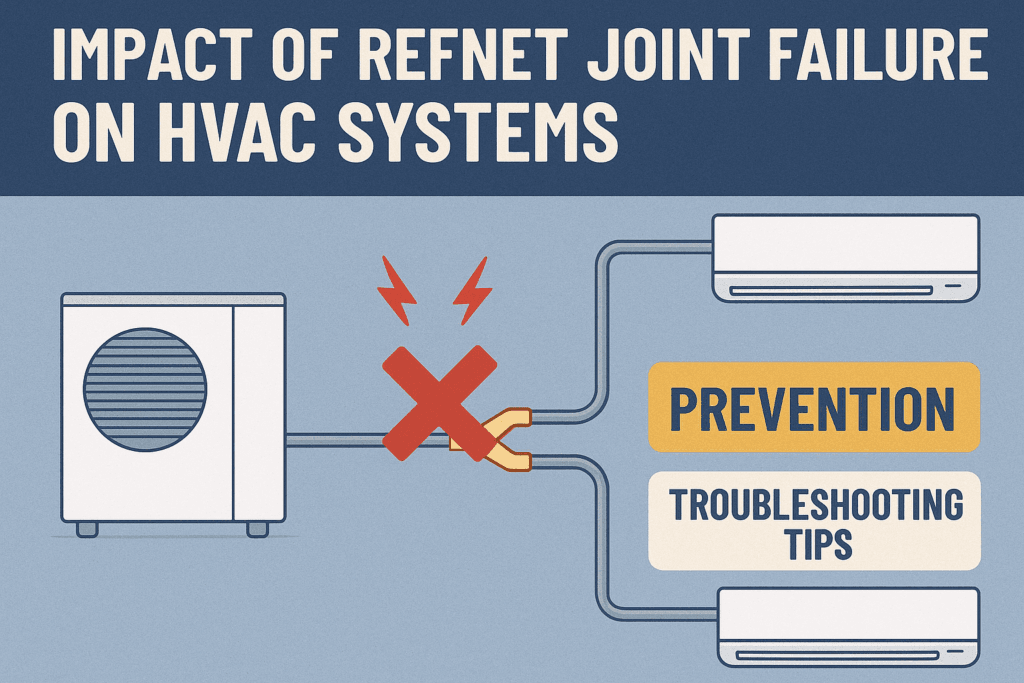Introduction
Intelligent HVAC technologies are required in modern buildings to ensure that buildings are comfortable, energy consumption is the least, and the environmental footprint is minimized. Of these, Variable Refrigerant Flow (VRF) systems, have gained particular popularity because they allow individual control of each zone by a single outdoor machine. A major part of the ability to do this exists within the Refnet joint.
Refnet joints are highly important but forgotten because they are very small. But in case they fail, they may have cascading and widespread repercussions, resulting in energy waste, the failure of components, and expensive repair charges. This blog discusses the repercussions of joint failure in Refnet, and factors to consider in prevention and troubleshooting so you can have a reliable and efficient HVAC system.
Understanding Refnet Joints in HVAC Systems
A Refnet joint is a specially designed component used in VRF systems to evenly split or merge the flow of refrigerant between the outdoor unit and multiple indoor units, ensuring balanced and efficient distribution throughout the system. The joints facilitate in linking the outdoor unit to several inside units with balanced refrigerant circulation. They play a critical role in ensuring that heating or cooling is circulated uniformly in various areas.
There are two typical fittings in Refnet setups, the Copper Tee Joint and the Copper Y Fitting. Although they may appear similar, they have been used in slightly different mechanical purposes as indicated below:
Copper Tee Joint vs. Copper Y Fitting
Feature | Copper Tee Joint | Copper Y Fitting |
|---|---|---|
| Design | T-shaped, with sharp angles | Y-shaped, with smoother angles |
| Flow Resistance | Higher | Lower |
| Pressure Drop | Moderate | Minimal |
| Application Suitability | Basic installations | Preferred for optimized VRF performance |
Customized insulation is another key that influences the joints performance, and this is made to resist by fitting customized insulation according to the shape and diameter of a joint. This insulation reduces thermal losses and condensation which may otherwise corrode system components and shorten its life as opposed to normal pipe wrap.
Common Causes of Refnet Joint Failure
Although Refnet joints perform a very essential task, failure can occur because of various reasons:
Improper brazing or welding: The inadequate workmanship may lead to less Denver springs or micro-cracks which increase over time.
➣ Incorrect alignment: The misaligned joints are in a state of continuous mechanical loading and therefore wear excessively.
➣ Lack of or poorly applied insulation: The joint may be damaged by thermal bridging or condensation without special insulation.
➣ Subpar materials: Poor-grade parts like poorly made brass fittings can erode quicker or even bend due to pressure.
➣ Mechanical stress and vibration: When the joint is not isolated, nearby compressors or external machinery may cause stress.
➣ Thermal cycling: Through this process of expansion and contraction through heating and cooling, the material becomes weak over time.
It is essential that installers and maintenance teams understand such causes to preserve the life of the entire HVAC.
Impact of Refnet Joint Failure on HVAC Systems
Even when a Refnet joint fails the consequences are seldom local. When undermined, these minor elements are able to instigate general vagueness. Here’s how:
➣ Refrigerant leakage: A pinhole opening can also short the cooling/heating capacity dramatically and be an expensive recharging process.
➣ Compressor damage: Working with low refrigerant places additional stress on the compressor which is one of the costly do-over parts.
➣ Zone imbalances: Failure may result in undercooling or overheating in certain zones affecting the occupant comfort.
➣ Higher operational costs: The system might be using increased power to recover losses increasing the energy costs.
➣ System downtime: Finding and fixing a failed joint sometimes necessitates partial or total shutdown.
Together, these issues have the potential to diminish the lifecycle of your HVAC system in general and to raise your aggregate cost of ownership.
Visual Table: Direct vs. Hidden Impacts of Joint Failure
Direct Impact | Hidden/Long-Term Consequences |
|---|---|
| Environmental damage | Environmental damage |
| Reduced system lifespan | Reduced system lifespan |
| Structural stress on pipes | Structural stress on pipes |
| Network-wide imbalance in VRF system | Network-wide imbalance in VRF system |
This table illustrates how a seemingly minor joint failure can gradually escalate into serious mechanical and environmental challenges.
Environmental Consequences
Besides inconvenience in operations, Refnet joint failure has environmental consequences. Refrigerants like R-410A and R-32, widely used in VRF systems, have high global warming potential and are considered potent greenhouse gases. Small leaks add up to high global warming.
When correctly installed and maintained VRF Refnet joints help reduce the environmental impact with integrity of the refrigerant remaining and energy savings achieved. The sealed joint system is not only resource-conserving but also compliments the shifting energy-related sustainability in the HVAC design and green building certifications.
Therefore, the cost savings that come with investing in quality joints and proactive maintenance are not merely reduced prices: it is a green decision.
Early Warning Signs to Watch For
Failure in refnet welding commonly starts in a subtle way. Early warning signs may reveal causes of full-blown system malfunctions, and they should be detected in time:
➣ Strange hissing noises inside the ceiling or walls
➣ Stains or residue of oil around smooth joints of pipes
➣ Room temperatures that are not at the same level, especially in multi-zone environments
➣ Refrigerant pressure- or flow-related system fault codes
➣ The presence of visible frost on indoor coils or pipes often indicates improper refrigerant distribution within the system.
Such symptoms can differ depending on the size and sophistication of the system, although they all indicate potential leakage of the refrigerant or an imbalance in the pressure.
Prevention Strategies
Prevention efforts would work miles to make sure that your HVAC system is not under the perils of joint issues. These are some of the tested strategies:
➣ Employ high-quality products such as Copper T-Joints and Copper Y Fitting that are ISO or ASTM compliant.
➣ Use tailor-made insulation based on the arrangement of your pipes to prevent material loss.
➣ Prepare technicians to use precision brazing and alignment methods–skillful installations can remove the majority of the hazards of failure.
➣ To prevent galvanic corrosion, install brass fittings in areas where the thermal and chemical content is compatible.
➣ Use isolation mounts and isolators around external units and compressors to limit the mechanical loading of adjacent joints.
➣ Arrange preventive maintenance check-ups after 3-6 months, including checks of the refrigerant level and other joint inspections.
Adapting these best practices in both installation and operation can greatly increase the life of your VRF system.
Troubleshooting Tips for Refnet Joint Failures
Troubleshooting the Refnet joints should be included in the checklist when an HVAC begins to perform poorly. Use the following formula:
➣ Visual Inspection: Begin by looking at spots of oil, discoloration of pipes, or signs of frost at crevices.
➣ Pressure Testing: Isolate the concerned branch and carry out a decay test using nitrogen or a vacuum to detect leaks.
➣ Thermal Imaging: Apply infrared cameras to identify heat loss joint areas- this also identifies areas of insulation failures.
➣ Electronic Leak Detectors: These tools are used to detect even smaller leaks of the refrigerant either acoustically or by means of trace gas.
➣ Component Replacement: Replacement of any defective joint that has been identified should be with a new properly sized and insulated fitting.
➣ System Rebalancing: When performing joint repair or replacement, be sure that the refrigerant levels and pressure are rebalanced to ensure a uniform flow.
Immediate measures include acting on the basis of these checks and eliminating the possibility of more profound malfunctions of the system and restoring performance in the shortest time.
Quick-Reference Table: Prevention vs. Troubleshooting
Area | Prevention Tip | Troubleshooting Action |
|---|---|---|
| Installation | Employ certified HVAC professionals | Re-inspect joints for alignment and brazing flaws |
| Insulation | Use high-quality customized insulation | Detect temperature gaps via thermal imaging |
| Fitting Material | Choose Copper Y Fitting or brass fitting wisely | Replace corroded or deformed components |
| Vibration Control | Install isolation mounts to prevent joint fatigue | Check for noise or stress fractures near joints |
| System Monitoring | Schedule quarterly refrigerant pressure checks | Review error codes and pressure drop logs |
This quick guide can be a handy checklist for HVAC teams to maintain system health year-round.
Conclusion
Physically, refnet joints can be small, but in the performance of the HVAC, the role they play is colossal. The failure of a component can lead to leakages of the refrigerant, temperature variation, extreme energy consumption as well as the failure of a compressor. Even more disastrous is that it may sneak past the environment with devastating results due to the emission of powerful greenhouse gases.
That’s why it’s crucial to pay attention to every detail—from selecting the right Copper Tee Joint or brass fitting, to properly applying customized insulation, and ensuring regular maintenance.
Combining their insight into the effects of Refnet joint failure and tips on prevention and troubleshooting, building managers and HVAC professionals can make their systems last longer, greener, and more efficiently.



